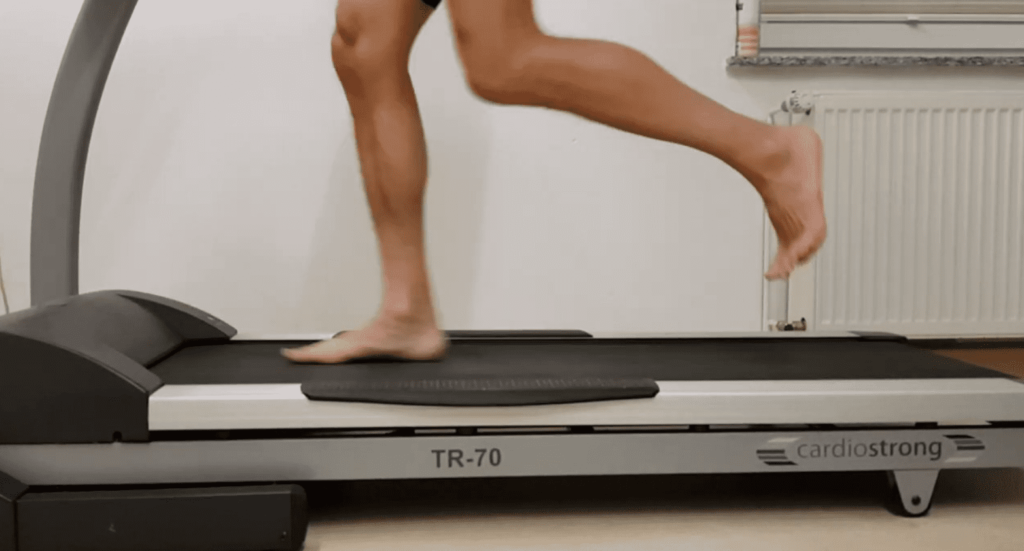There are several factors that influence the usage of a treadmill. Some people enjoy short bouts of intense workouts while others prefer long and steady runs.
Some people run on a treadmill while watching new episodes of Stranger Things while others prefer to direct their attention and efforts into running with upbeat music.
A growing body of research shows that walking barefoot on a treadmill has a positive effect on enhancing a person’s memory when compared to running with shoes.
In this article, we will not only discuss this in detail but also understand the pros and cons of walking barefoot on a treadmill.
We will also have a peak on tips to prevent treadmill injuries.
Let’s get started.
Is It Better To Walk Barefoot On A Treadmill?
It is better to run or walk barefoot on a treadmill. Research has found various benefits of walking barefoot on a treadmill. It helps in overcoming chronic conditions like diabetes and obesity.

It also helps enhance the runner’s memory, as the runner has to pay serious attention to avoid stepping on sharp objects, which also enhances the runner’s form.
That said, whether you are running barefoot outdoors or on a treadmill, it requires some precautions that must be taken care of before you start.
Pros & Cons Of Walking Barefoot On A Treadmill
Running or walking barefoot on a treadmill may be beneficial for a person and harmful for others. It mostly depends on an individual runner’s skill level and form.
Pros of Walking Barefoot On A Treadmill
The flexibility and convenience of jogging barefoot account for the majority of the advantages.
Additionally, running barefoot may help reduce impact, improve balance and concentration, and offer the calves a better workout.
Obviously, this depends on the ability and form of each runner. Running barefoot could be advantageous for some, but it might be challenging for others.
Running barefoot has a stronger impact on your memory than running with shoes.
The University of North Florida researchers have found that memory is improved after at least 16 minutes of barefoot running.
Due to the additional tactile demands of barefoot running, the barefoot condition appears to process sensory feedback more quickly. This suggests that running may be related to memory.
Cons of Walking Barefoot On A Treadmill
Let’s see some challenges that you may face while walking barefoot on a treadmill.
1. Potential cuts and scrapes on the skin of the foot
Due to the rough surface of the treadmill, you may get blisters, cuts, and scrapes on the bottom of your foot if you are walking barefoot on a treadmill.
Additionally, the treadmill may get hot and cause irritation or a burning sensation on the bottom of your feet.
2. The treadmill comes towards you ‘
Walking or running on a treadmill is different from running outdoors. When you are running on a treadmill, the force is directed towards the toes, which puts additional strain on barefoot.
Decreasing speed and increasing the incline can help you avoid this. Eventually, this will help you land on the treadmill barefoot.
3. Breaks under Stress
A stress fracture is a little fracture brought on by continuous stress.
Due to running’s high impact, runners are already at risk for stress fractures; nevertheless, poor foot support may worsen the condition.
Also, read:
- What Is Underhand Front Raise? How Can You Do It?
- 14 Proven Benefits of Doing 100 Jumping Jacks a Day
Few Things To Consider Before Starting To Run Barefoot On A Treadmill
Walking around barefoot may seem unusual at first, but it provides several advantages.
Going barefoot has been known to provide various health benefits, including reduced stress, foot pain, and boosted blood flow throughout the body.
If you’re prepared to make a few tweaks, jogging barefoot on a treadmill is a realistic alternative when the weather doesn’t permit it.
Unlike running outdoors, using a treadmill provides a stable and safe running surface. You’ll probably need to change your running technique and the treadmill’s settings in order to go barefoot on a treadmill securely.
Running barefoot on a treadmill shouldn’t hurt, but if it does, stop using the machine until you consult with your doctor again.
There are a few things that you must consider and need to take care of before you start running barefoot on a treadmill.
There are numerous types of treadmills. The first three considerations for selecting one are:
- low heat output
- the mechanism for suspending decks
- a smooth running belt for comfort
When you are selecting a treadmill, and you intend to run barefoot on it, keep the following in mind:
1. Shock Absorption
It is important to understand and examine your treadmill for shock absorption. If your treadmill has inadequate shock absorption, then it might cause you joint pain.
If you do not want to face any problems related to this, you can also invest in a good treadmill mat that will reduce noise and provide shock absorption.
2. Length of the running deck
The length of the running deck of a treadmill should be 64 inches.
Treadmills with shorter decks are better for walking, and longer decks are better for running. A wooden board beneath your running belt and longer decks are ideal for running barefoot on a treadmill.
3. Running belt texture
Because a running belt is made for shoes, its surface is rough. It is recommended to start with shorter times and gradually extend them.
Tips To Prevent Treadmill Injuries
Here are some tips to prevent injuries from Treadmill:
1. Start slowly
It is advised to hold off on using treadmills at first if you are new to barefoot running. Give your feet some time to adjust to going barefoot. You can practice barefoot walking before gradually moving on to running.
2. Ideal adjustment to the treadmill
To keep the feet safe, you would need to combine different speeds and incline levels often.
The same parts of the legs are repeatedly used while walking or running barefoot on a treadmill. Altering speed and incline can avoid this continuous motion, lowering the risk of overuse damage.
3. Be alert while running barefoot on a treadmill
The healthiness of your feet is directly impacted by how you land when running barefoot on a treadmill.
You allow your toes adequate room, make sure to rest on your midfoot, take quick, light steps, and run a little behind where you would usually stay on the treadmill.
You may also like:
- What Are The Results For 30 Minutes A Day On Stationary Bike?
- Home Gym Vs Gym Membership: Which Is A Better Choice?
Is Running On A Treadmill Better Than Running Outside?
There are numerous pros and cons to both running on a treadmill and running outside.
We have discussed them fairly in the article. While some people prefer one over the other, some enjoy doing both.
Ultimately, the best way to determine which works better for you is to experiment with both and see which you prefer. Each option also has some differences in the calorie-burning potential.

If you are someone who enjoys running outdoors, you may find that you have more energy when running on natural terrain.
You may also find that running outdoors helps clear your head and reduces stress hormones.
However, running outdoors can also be difficult in extreme weather conditions, and you may need to be careful of hazards such as traffic or uneven surfaces.
Running on a treadmill can be a viable option if you want to burn more calories.
This is because treadmills typically have an incline feature, which can help you burn more calories than running on level ground outdoors.
Treadmills can also be a good option if you are trying to avoid bad weather conditions or hazardous terrain.
However, some people find that running on a treadmill can be boring, and the monotony can make it difficult to stick with your workout routine.
Running outdoors also exposes you to fresh air and natural light, which can have benefits for your mental health.
If you love being outdoors, running outside is probably the better option for you. However, if you prefer the predictability of the treadmill, then by all means, continue using it.
When it comes to choosing the right shoes for treadmill running, consider both comfort and performance. Here’s what you need to know:
What shoes should I wear on the treadmill?
When it comes to choosing the right shoes for treadmill running, you should consider both comfort and performance. Here’s what you need to know:
Treadmill-Specific Shoes:
1. Lightweight and Breathable: Since treadmill running is low-impact compared to outdoor running, opt for lightweight shoes with good breathability. You don’t need as much cushioning as you would for road or trail running.
2. Responsive Soles: Look for shoes with responsive soles that provide good energy return. This helps propel you forward during your treadmill workouts.
3. Supportive Fit: Shoes should offer stability and support. A snug fit around the midfoot and heel prevents slipping.
4. Avoid Over-Cushioning: While some cushioning is essential, avoid heavily cushioned shoes that may feel bulky on the treadmill.
Can You Wear Road Running Shoes on a Treadmill?:
Yes, you can! Road running shoes are generally suitable for treadmill use.
Avoid Hybrid Shoes: Avoid hybrid shoes designed for road and trail running. They may have extra grippy soles that are unnecessary for treadmill surfaces.
Avoid Aggressive Lugs: Shoes with aggressive lugs can damage the treadmill belt.
Conclusion
Running or walking barefoot on a treadmill might be difficult. But it can still be safe and healthy with a few minor technique adjustments and awareness.
Running on a treadmill offers health benefits similar to running outside. Because of the tactile connection between your legs and the treadmill, you can improve your memory as a result.
You can more easily achieve the workout you require in a number of ways. Your home treadmill makes it simpler for you to run long distances while removing road hazards like gravel, potholes, and traffic.
By the end, you’ll also have improved intellectually. Sounds like a situation where everyone benefits!

